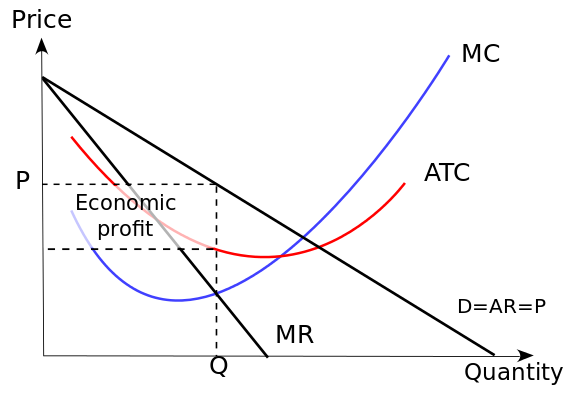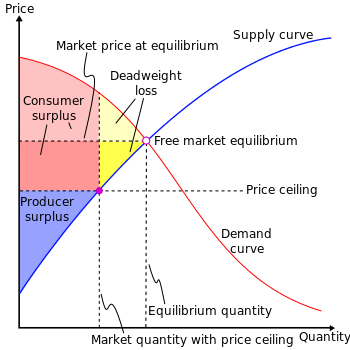11.4: Impacts of Monopoly on Efficiency
- Last updated
- Jul 17, 2023
- Save as PDF
- Page ID
- 3501

- Boundless
- Boundless
( \newcommand{\kernel}{\mathrm{null}\,}\)
Reasons for Efficiency Loss
A monopoly generates less surplus and is less efficient than a competitive market, and therefore results in deadweight loss.
learning objectives
- Evaluate the economic inefficiency created by monopolies
Monopoly
A monopoly exists when a specific enterprise is the only supplier of a particular commodity. Monopolies have little to no competition when producing a good or service. A monopoly is a business entity that has significant market power (the power to charge high prices).
Inefficiency in a Monopoly
In a monopoly, the firm will set a specific price for a good that is available to all consumers. The quantity of the good will be less and the price will be higher (this is what makes the good a commodity). The monopoly pricing creates a deadweight loss because the firm forgoes transactions with the consumers. The deadweight loss is the potential gains that did not go to the producer or the consumer. As a result of the deadweight loss, the combined surplus (wealth) of the monopoly and the consumers is less than that obtained by consumers in a competitive market. A monopoly is less efficient in total gains from trade than a competitive market.
Monopolies can become inefficient and less innovative over time because they do not have to compete with other producers in a marketplace. For private monopolies, complacency can create room for potential competitors to overcome entry barriers and enter the market. Also, long term substitutes in other markets can take control when a monopoly becomes inefficient.
Market Failure
When a market fails to allocate its resources efficiently, market failure occurs. In the case of monopolies, abuse of power can lead to market failure. Market failure occurs when the price mechanism fails to take into account all of the costs and/or benefits of providing and consuming a good. As a result, the market fails to supply the socially optimal amount of the good. A monopoly is an imperfect market that restricts output in an attempt to maximize profit. Market failure in a monopoly can occur because not enough of the good is made available and/or the price of the good is too high. Without the presence of market competitors it can be challenging for a monopoly to self-regulate and remain competitive over time.

Imperfect competition: This graph shows the short run equilibrium for a monopoly. The gray box illustrates the abnormal profit, although the firm could easily be losing money. A monopoly is an imperfect market that restricts the output in an attempt to maximize its profits.
Understanding and Finding the Deadweight Loss
In economics, deadweight loss is a loss of economic efficiency that occurs when equilibrium for a good or service is not Pareto optimal.
learning objectives
- Define deadweight loss, Explain how to determine the deadweight loss in a given market.
Deadweight Loss
In economics, deadweight loss is a loss of economic efficiency that occurs when equilibrium for a good or service is not Pareto optimal. When a good or service is not Pareto optimal, the economic efficiency is not at equilibrium. As a result, when resources are allocated, it is impossible to make any one individual better off without making at least one person worse off. When deadweight loss occurs, there is a loss in economic surplus within the market. Deadweight loss implies that the market is unable to naturally clear.
Causes of Deadweight Loss
Deadweight loss is the result of a market that is unable to naturally clear, and is an indication, therefore, of market inefficiency. The supply and demand of a good or service are not at equilibrium. Causes of deadweight loss include:
- imperfect markets
- externalities
- taxes or subsides
- price ceilings
- price floors
Determining Deadweight Loss
In order to determine the deadweight loss in a market, the equation P=MC is used. The deadweight loss equals the change in price multiplied by the change in quantity demanded. This equation is used to determine the cause of inefficiency within a market.
For example, in a market for nails where the cost of each nail is $0.10, the demand will decrease from a high demand for less expensive nails to zero demand for nails at $1.10. In a perfectly competitive market, producers would charge $0.10 per nail and every consumer whose marginal benefit exceeds the $0.10 would have a nail. However, if one producer has a monopoly on nails they will charge whatever price will bring the largest profit. If they charge $0.60 per nail, every party who has less than $0.60 of marginal benefit will be excluded. When equilibrium is not achieved, parties who would have willingly entered the market are excluded due to the non-market price.
An example of deadweight loss due to taxation involves the price set on wine and beer. If a glass of wine is $3 and a glass of beer is $3, some consumers might prefer to drink wine. If the government decides to place a tax on wine at $3 per glass, consumers might choose to drink the beer instead of the wine. At times, policy makers will place a binding constraint on items when they believe that the benefit from the transfer of surplus outweighs the adverse impact of deadweight loss.

Deadweight loss: This graph shows the deadweight loss that is the result of a binding price ceiling. Policy makers will place a binding price ceiling when they believe that the benefit from the transfer of surplus outweighs the adverse impact of the deadweight loss.
Key Points
- The monopoly pricing creates a deadweight loss because the firm forgoes transactions with the consumers.
- Monopolies can become inefficient and less innovative over time because they do not have to compete with other producers in a marketplace.
- In the case of monopolies, abuse of power can lead to market failure. Market failure occurs when the price mechanism fails to take into account all of the costs and/or benefits of providing and consuming a good.
- A monopoly is an imperfect market that restricts output in an attempt to maximize profit. Without the presence of market competitors it can be challenging for a monopoly to self-regulate and remain competitive over time.
- When deadweight loss occurs, there is a loss in economic surplus within the market.
- Causes of deadweight loss include imperfect markets, externalities, taxes or subsides, price ceilings, and price floors.
- In order to determine the deadweight loss in a market, the equation P=MC is used. The deadweight loss equals the change in price multiplied by the change in quantity demanded.
Key Terms
- monopoly: A market where one company is the sole supplier.
- market failure: A concept within economic theory describing when the allocation of goods and services by a free market is not efficient.
- inefficient: Incapable of, or indisposed to, effective action; habitually slack or remiss; effecting little or nothing; as, inefficient workers; an inefficient administrator.
- equilibrium: The condition of a system in which competing influences are balanced, resulting in no net change.
- deadweight loss: A loss of economic efficiency that can occur when equilibrium for a good or service is not Pareto optimal.
LICENSES AND ATTRIBUTIONS
CC LICENSED CONTENT, SPECIFIC ATTRIBUTION
- Allocative inefficiency. Provided by: Wikipedia. Located at: en.Wikipedia.org/wiki/Allocative_inefficiency. License: CC BY-SA: Attribution-ShareAlike
- Monopoly. Provided by: Wikipedia. Located at: en.Wikipedia.org/wiki/Monopoly. License: CC BY-SA: Attribution-ShareAlike
- IB Economics/Microeconomics/Market Failure. Provided by: Wikibooks. Located at: en.wikibooks.org/wiki/IB_Econ...Market_Failure. License: CC BY-SA: Attribution-ShareAlike
- inefficient. Provided by: Wiktionary. Located at: en.wiktionary.org/wiki/inefficient. License: CC BY-SA: Attribution-ShareAlike
- Boundless. Provided by: Boundless Learning. Located at: www.boundless.com//economics/...ition/monopoly. License: CC BY-SA: Attribution-ShareAlike
- market failure. Provided by: Wikipedia. Located at: en.Wikipedia.org/wiki/market%20failure. License: CC BY-SA: Attribution-ShareAlike
- Imperfect competition in the short run. Provided by: Wikimedia. Located at: commons.wikimedia.org/wiki/Fi..._short_run.svg. License: CC BY-SA: Attribution-ShareAlike
- Applying The Competitive Model - Econ 302. Provided by: Wikidot. Located at: http://econ302.wikidot.com/applying-the-competitive-model. License: CC BY-SA: Attribution-ShareAlike
- Deadweight loss. Provided by: Wikipedia. Located at: en.Wikipedia.org/wiki/Deadweight_loss. License: CC BY-SA: Attribution-ShareAlike
- Deadweight Loss - Microeconomics Wiki. Provided by: Wikidot. Located at: http://econwiki.wikidot.com/deadweight-loss. License: CC BY-SA: Attribution-ShareAlike
- Dead weight loss. Provided by: Wikipedia. Located at: en.Wikipedia.org/wiki/Dead_weight_loss. License: CC BY-SA: Attribution-ShareAlike
- Pareto efficiency. Provided by: Wikipedia. Located at: en.Wikipedia.org/wiki/Pareto_efficiency. License: CC BY-SA: Attribution-ShareAlike
- deadweight loss. Provided by: Wikipedia. Located at: en.Wikipedia.org/wiki/deadweight%20loss. License: CC BY-SA: Attribution-ShareAlike
- equilibrium. Provided by: Wiktionary. Located at: en.wiktionary.org/wiki/equilibrium. License: CC BY-SA: Attribution-ShareAlike
- Imperfect competition in the short run. Provided by: Wikimedia. Located at: commons.wikimedia.org/wiki/Fi..._short_run.svg. License: CC BY-SA: Attribution-ShareAlike
- Deadweight-loss-price-ceiling. Provided by: Wikipedia. Located at: en.Wikipedia.org/wiki/File:De...ce-ceiling.svg. License: CC BY-SA: Attribution-ShareAlike

